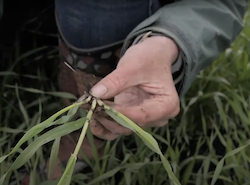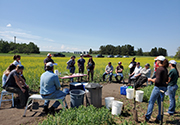| |
| |
 |
 |
| |
 |
|
@{mv_date_MMM d, yyyy}@ |
|
| |
 Spot-treating soil with the mineral reduced the overall occurrence and severity of the disease by 35 to 91 per cent.
» Read more...
Spot-treating soil with the mineral reduced the overall occurrence and severity of the disease by 35 to 91 per cent.
» Read more...
The bioeconomy – part of the green economy – is based on the production and sale of products other than foodstuffs made from agricultural, aquatic and forestry resources.
» Read more...
Grasshoppers are also lingering around the edges of fields in Manitoba, and crop protection companies are keeping an eye on supply levels.
» Read more...
|
| |
|
| |
 Does it make sense to apply a plant growth regulator (PGR) in winter cereals? A newly released study analyzing the effects of dose and application timings of the PGR trinexapac-ethyl (sold under the name Moddus in Canada) on lodging, yield and quality of winter cereals suggests there’s a role for trinexapac-ethyl (TE) in some systems. The study, which was carried out over three years across six locations in Western Canada, sought to find a PGR that was ready to use right away in winter cereals.
» Learn more...
Does it make sense to apply a plant growth regulator (PGR) in winter cereals? A newly released study analyzing the effects of dose and application timings of the PGR trinexapac-ethyl (sold under the name Moddus in Canada) on lodging, yield and quality of winter cereals suggests there’s a role for trinexapac-ethyl (TE) in some systems. The study, which was carried out over three years across six locations in Western Canada, sought to find a PGR that was ready to use right away in winter cereals.
» Learn more... |
| |
 Mary Ruth McDonald has always had an interest in plants, which led her to the University of Guelph, the study of plant pathology and an interest in crop protection. But it was a summer job as a pest management scout that clarified what she wanted to do with those interests. McDonald has spent almost her entire career focused on on vegetable cropping in the unique agricultural production conditions of the Holland Marsh, acting as a bridge between research and application in the field. In this episode of AgAnnex Talks, McDonald shares what she’s learned from trying new things, and what she loves about seeing research in action.
» Listen now...
Mary Ruth McDonald has always had an interest in plants, which led her to the University of Guelph, the study of plant pathology and an interest in crop protection. But it was a summer job as a pest management scout that clarified what she wanted to do with those interests. McDonald has spent almost her entire career focused on on vegetable cropping in the unique agricultural production conditions of the Holland Marsh, acting as a bridge between research and application in the field. In this episode of AgAnnex Talks, McDonald shares what she’s learned from trying new things, and what she loves about seeing research in action.
» Listen now... |
| |
|
| |
 Soil acidification adversely affects soil health, nutrient availability and the composition of the root exudates, which attracts soilborne pathogens and causes root-borne diseases such as root rot. Using soil amendments that can improve soil pH may enhance soil health and nutrient uptake. A recent Alberta project assessed five different soil amendments to learn their impact on root rot.
» Read more...
Soil acidification adversely affects soil health, nutrient availability and the composition of the root exudates, which attracts soilborne pathogens and causes root-borne diseases such as root rot. Using soil amendments that can improve soil pH may enhance soil health and nutrient uptake. A recent Alberta project assessed five different soil amendments to learn their impact on root rot.
» Read more... |
| |
|
| |
|
|
| |
| |






